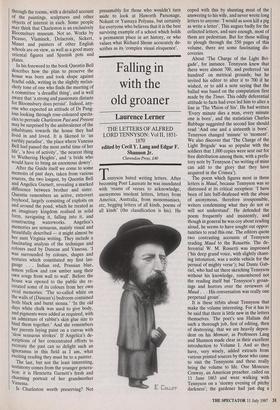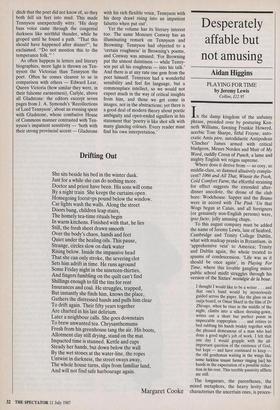Falling in with the old groaner
Laurence Lerner
THE LETTERS OF ALFRED LORD TENNYSON: Vol II, 1851- 1870 edited by Cecil Y. Lang and Edgar F. Shannon Jr.
Clarendon Press, PIO
Tennyson hated writing letters. After becoming Poet Laureate he was inundated with 'reams of verses to acknowledge, anonymous insolent letters, letters from America, Australia, from monomaniacs, etc, begging letters of all kinds, poems of all kinds' (the classification is his). He coped with this by shunting most of the answering to his wife, and never wrote long letters to anyone: 'I would as soon kill a pig as write a letter'. This augurs badly for the collected letters, and sure enough, most of them are pedestrian. But for those willing to plough through the 550 pages of this volume, there are some fascinating dis- coveries.
About 'The Charge of the Light Bri- gade', for instance. Tennyson knew that there were almost 700, and preferred 'six hundred' on metrical grounds; but he invited his editor to alter it to 700 if he wished, or to add a note saying that the ballad was based on the computation first made by the Times. This oddly deferential attitude to facts had even led him to alter a line in 'The Vision of Sin'. He had written 'Every minute dies a man, every minute one is born', and the statistician Charles Babbage suggested the second line should read 'And one and a sixteenth is born'. Tennyson changed 'minute' to 'moment'. We also discover that 'The Charge of the Light Brigade' was so popular with the soldiers that 1,000 copies were sent out for free distribution among them, with a prefa- tory note by Tennyson ('no writing of mine can add to the glory that they have acquired in the Crimea').
The poem which figures most in these letters is Maud, because Tennyson was so distressed at its critical reception: 'I have been of late half-deafened with the abuse of anonymous, therefore irresponsible, writers condemning what they do not or will not understand'. He defended the poem frequently and insistently, and though in general he was coy about reading aloud, he seems to have sought out oppor- tunities to read this one. The editors quote two contrasting accounts of Tennyson reading Maud to the Rossettis. The de- ferential W. M. Rossetti was impressed ('his deep grand voice, with slightly chant- ing intonation, was a noble vehicle for the perusal of mighty verse'); but Dante Gab- riel, who had sat there sketching Tennyson without his knowledge, remembered not the reading itself but 'Tennyson's groan- ings and horrors over the reviewers of Maud. . . His conversation was really one perpetual groan'.
It is these titbits about Tennyson that make the volume interesting. For it has to be said that there is little new in the letters themselves. The poet's son Hallam did such a thorough job, first of editing, then of destroying, that we are heavily depen- dent on his Memoir, as Professors Lang and Shannon made clear in their excellent introduction to Volume I. And so they have, very wisely, added extracts from various printed sources by those who came to visit the Tennysons and these really bring the volume to life. One Moncure Conway, an American preacher, called on 11 June 1863 and went walking with Tennyson on a 'stormy evening of pitchy darkness'; the gardener had just dug a ditch that the poet did not know of, so they both fell six feet into mud. This made Tennyson unexpectedly witty. 'His deep bass voice came through the congenial darkness like mirthful thunder, while he groped until he found a path. "That this should have happened after dinner!", he exclaimed. "Do not mention this to the temperance folk." ' As often happens in letters and literary biographies, more light is thrown on Ten- nyson the Victorian than Tennyson the poet. Often he comes clearest to us in comparison with others — Edward Lear, Queen Victoria (how similar they were, in their fulsome earnestness), Carlyle, above all Gladstone: the editors excerpt seven pages from J. A. Symonds's 'Recollections of Lord Tennyson', about an evening spent with Gladstone, whose combative House of Commons manner contrasted with Ten- nyson's impatient sensitivity — 'both with their strong provincial accent — Gladstone with his rich flexible voice, Tennyson with his deep drawl rising into an impatient falsetto when put out'.
Yet the volume has its literary interest too. The same Moncure Conway has an illuminating remark on Tennyson and Browning: Tennyson had objected to a 'certain roughness' in Browning's poems, and Conway was amused: 'For Browning put the utmost daintiness — while Tenny- son put all his roughness — into his talk.' And there is at any rate one gem from the poet himself. Tennyson had a wonderful sensibility and feel for language, but a commonplace intellect, so we would not expect much in the way of critical insights from him, and those we get come in images, not in the abstractions; yet there is a good deal of modern theory about poetic ambiguity and open-ended signifiers in his statement that 'poetry is like shot silk with many glancing colours. Every reader must find his own interpretation.'



















































 Previous page
Previous page